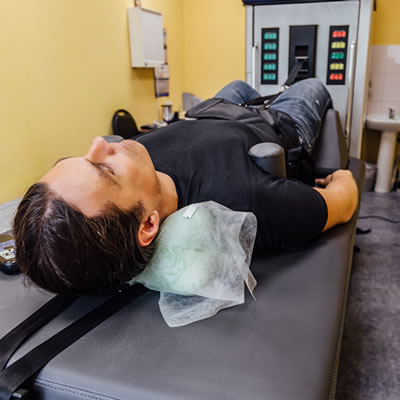 Spinal decompression is a well-researched and effective non-invasive intervention for spinal pain. Many patients consider spinal decompression, also known as spinal traction, as an alternative to surgery to address back pain. To understand how spinal decompression therapy works, it’s important to understand the key players, our intervertebral discs and spinal vertebrae.
Spinal decompression is a well-researched and effective non-invasive intervention for spinal pain. Many patients consider spinal decompression, also known as spinal traction, as an alternative to surgery to address back pain. To understand how spinal decompression therapy works, it’s important to understand the key players, our intervertebral discs and spinal vertebrae.
Intervertebral Discs
Intervertebral discs are cartilaginous structures that account for about 30% of the spine’s height. These discs are layered in between the bones of your spinal column, which are called spinal vertebrae. The functions of these discs include allowing for structured spinal flexibility, the prevention of intervertebral grinding with movement, and shock absorption. These discs are composed primarily of water and collagen surrounded by fibrous connective tissue. The discs are attached to your vertebrae via cartilage. When these discs become disrupted, back pain may occur. Common sources of back pain include disc bulges, disc herniation, and degenerative disc disease.
Bulging Discs
Bulging discs occur when a portion of these intervertebral discs protrudes out. This may cause symptoms of pain and discomfort and can be diagnosed definitively via MRI.
Herniated Discs
Disc herniations occur when the outer layer of cartilage that contains the disc is ruptured, causing the contents of the disc to spill out. Disc herniations cause pain and may also cause numbness, weakness, and/or tingling. This is because the disc material expelled from the disc often compresses surrounding nerves or irritates the nerve roots, leading to inflammation and causing associated nerve pathology. Herniated discs may occur due to a trauma or accident. They may also happen with a seemingly-benign twist or strain because of increased disc fragility with age.
Degenerative Disc Disease
Degenerative disc disease occurs when the disc begins to thin, often due to wear and tear. As the disc thins, the vertebrae begin to get closer together, which may lead to bone spurring and arthritic pain.
Spinal Column
The function of the spine is to provide a framework and support for the structures of the body to allow for movement and stability. The spine is composed of bones called vertebrae. The spinal canal, on the back side of the spine, works like a tunnel to house and protect nerves and blood vessels. When space is limited in the spinal column, pain and discomfort may ensue as a result of spinal stenosis.
Spinal Stenosis
Spinal stenosis occurs when there is encroachment on the spinal column, causing compression of the spinal nerves. At the structural level, spinal stenosis can occur as a result of wear and tear conditions like arthritis. This is because arthritis causes the production of new, pathological bony growths called bone spurs that can narrow the spinal canal and compress nerves.
Oftentimes, there is more than one cause of spinal pain and these causes may relate to both vertebral and disc pathology. One common example of this is sciatica.
Sciatica
Sciatica, defined simply as pain down the leg, is caused by compression of the sciatic nerve. This compression may result from disc bulging, disc herniation, and/or spinal stenosis.
How does spinal decompression therapy address back pain?
Spinal decompression therapy works to create space in the spinal column to allow for repair. This creates negative pressure within the spinal column which works like a vacuum to pull disc material back into the disc. In addition to disc material, spinal decompression therapy draws nutrients into the spinal column to bolster the body’s ability to heal itself. Because the spinal column doesn’t have its own blood supply, this action of pulling blood and nutrients into the disc helps expedite and support the body’s healing process.
References:
Degenerative disc disease. Degenerative Disc Disease | Johns Hopkins Medicine. (2021, December 15). Retrieved November 16, 2022, from https://www.hopkinsmedicine.org/health/conditions-and-diseases/degenerative-disc-disease
Mayo Foundation for Medical Education and Research. (2022, February 8). Herniated disk. Mayo Clinic. Retrieved November 16, 2022, from https://www.mayoclinic.org/diseases-conditions/herniated-disk/symptoms-causes/syc-20354095
Mayo Foundation for Medical Education and Research. (2022, October 25). Spinal Stenosis. Mayo Clinic. Retrieved November 16, 2022, from https://www.mayoclinic.org/diseases-conditions/spinal-stenosis/symptoms-causes/syc-20352961

